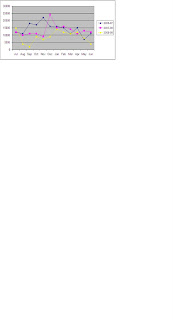Now the RWH itself is a storage sytem (not ground-water recharge) which had to be adapted to the constraints of the house and the experience of getting it done (design and implementation) is an interesting story which I will share in another post as I see many parallels to how we develop software…
I have taken the data from July to June for the last three years (somewhat aligns to the monsoon plus the fact that I got it done last August).
Total consumption (pre-installation) for 2006-07 was 1,71,000 litres
and for 2007-08 was 1,58,000 litres
while for 2008-09 (post installation) is 1,07,000 litres.
This implies a savings of 51,000 litres as compared to the previous year which is significant in my opinion considering that the consumption prior to RWH also is not very high (based on a norm of 135 litres/per person / per day which works out to 1,48,000 litres per year for a family of three).
Now translating this to money what does it imply?
Assuming a 5000 litre tanker costs Rs 500 the water savings translate to Rs 5100/year. The investment for the RWH was about Rs 25,000 - so it would need 5 years (with the kind of rains we received last year) to recover the costs. But if you consider BWSSB rates which do not even cover their costs it will be a long long time to recover the investment. This brings up an interesting topic - how does one measure the benefits of any such initiative? Should one go only by the economic value and miss on the bigger picture? Also it was easy in my case to measure since I had a storage system built but the same would not be possible if one sets up a groundwater recharge system.


No comments:
Post a Comment